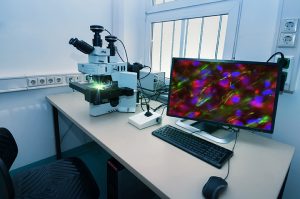Fluorescence due to its high sensitivity, specificity and simplicity is used in a wide range of applications including analytical and biotechnology activities. Optical fluorescence occurs when a molecule absorbs light within its reflection band and emits light within its emission band.
Fluorescence instruments such as microscopes use optical fluorescence filters to pass only certain types of light while filtering out others. This helps increase the resulting image quality and also minimizes specimen damage.
But what are fluorescence filters?

Some of the most common questions we get from our clients include, what are fluorescence filters, and how do fluorescence microscopy filters work?
Fluorescence filters are used in microscopy to allow the reflection of certain types of light, colors, or elements while also allowing the transmission of others.
A fluorescence microscope is a type of optical microscope that uses fluorescence to examine small details or objects. Fluorescence microscopy uses optical filters to allow the transmission of certain lights through the microscope lens. This way, researchers can be able to observe specific details in objects that wouldn’t be visible to the naked eye under normal circumstances.
Different types of fluorescence filters are usually housed in a fluorescence filter cube to help enhance the visibility of small objects or details in epifluorescence microscopy, as explained below.
The primary filtering element in a fluorescence microscope is a set of three filters that are housed in a block or a filter slide. In modern microscopes, these three filters are usually interference filters.
A typical fluorescence microscope has the following three basic optical filters:
When fluorescent materials are excited by ultraviolet light, they emit light. The excitation filter, also called an exciter, permits selected light from the illuminator to pass through to the specimen.
In the past, excitation filters were mainly short-pass filters. However, today they are almost exclusively band-pass filters. This band-pass filter is designed to transmit wavelengths of the illumination light that excites a specific dye in the specimen.
The minimum transmission of the excitation filter is what determines the brightness of the final image. Generally, excitation filters are required to have a 40% transmission minimum if they’re to give bright well lit images.
The emission filter also referred to as the barrier filter or the emitter blocks unwanted light outside of the emission band. This filter also blocks any other light emitted from outside the fluorophore. It only allows light emitted by the fluorophore to pass through. This filter can either be long-pass or band-pass.
Barrier filters play an important role as by blocking unwanted light they ensure a dark background that prevents the image from getting distorted or cluttered due to too much light.
Emission filters come in different shapes, sizes and some have multiple layers. These filters are also made of different materials including plastic, glass and gold. The emission filter usually has a fixed value meaning that once it’s included in the microscope, it doesn’t need a replacement. This helps prolong the life of the fluorescence microscope.
The dichroic beamsplitter also referred to as dichroic mirror is an edge filter used to restrict the viewing angle to specific bands of the electromagnetic spectrum. This filter allows specific wavelengths to pass through the filter while blocking others.
The dichroic filter is usually used at an oblique 45 angle of incidence to efficiently reflect and transmit light in the excitation and emission band respectively. Dichroic mirrors are also used to separate different light colors while excluding unwanted light.

Microscopes use light to view small objects. Unlike in the past, when glass lenses were used to focus light on microscopes, modern-day microscopes use interference filters.
Fluorescence microscopy uses filters to reduce the scattering of light by a sample, while also helping to block certain light wavelengths. Filters also help to direct light towards the sample during imaging.
Additionally, the use of both excitation and emission filters enables the detection of several fluorophores. When these filters are mounted on a filter wheel, they can rotate and detect signals from several fluorophores in quick succession and with high precision.
Other notable reasons why we use filters in microscopy include:
Depending on their function, filters are inserted into the light path at differing points. Notably, choosing the right type of filter for your microscope is important as it helps enhance imaging capabilities.
Further, for simplification and ease of use, you can use fluorescent microscope filter cubes to collect and store fluorescent samples. Such cubes are divided into three sections, with each section having a different type of filter.
The first filter that the light comes into contact with in the filter cube is the excitation filter. This filter only allows the appropriate excitation wavelength to pass through. Then, the light that passes through the excitation filter reflects on the surface of the dichroic beamsplitter, which is tilted at a 450 angle. This filter separates the excitatory light from the one emitted by the fluorophore. The light later encounters the emission filter, which allows the light of a certain wavelength interval to pass and blocks any other background light. Finally, the fluorescence encounters a prism that reflects light towards the microscope eyepiece, allowing you to capture a high-resolution image.
One can insert a sample into each of the appropriate sections of the cube during sample examination. Since the cubes are divided into different sections, it becomes easier to isolate each type of sample for analysis. Besides, the cubes make it possible for researchers to view samples under fluorescence microscopes without having to remove the microscope slides.
Notably, when shopping for filters, you need to know the naming used, as there are a lot of unusual conventions for filter names that can be confusing. Besides, most filter manufacturers use their nomenclature. To help you easily identify various filter types, here’s their nomenclature:
Fluorescence microscopy is an important tool for scientific research. A crucial part of microscopy is ensuring that a sample gets the correct light illumination. Filters provide an excellent way to filter light that passes through fluorescence microscopes to the sample. Ensuring that the correct types of filters are used in fluorescence microscopy helps maximize image quality and reduce specimen damage.
If you’re looking for optical components, talk to us. We are manufacturers of quality and cost-effective optical components for the photonics industry. Contact us today for all your optical engineering needs.